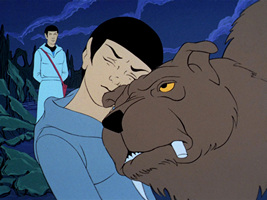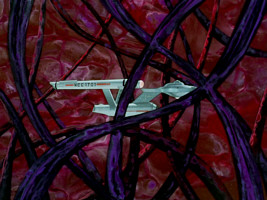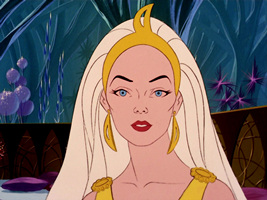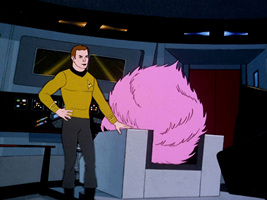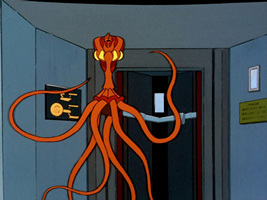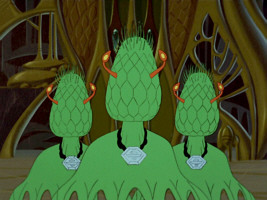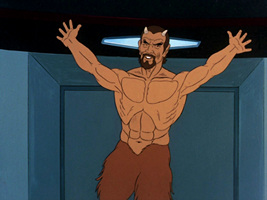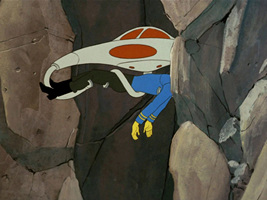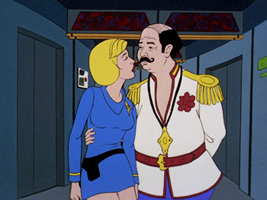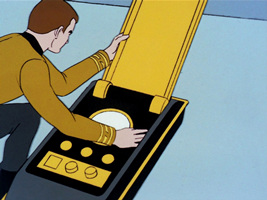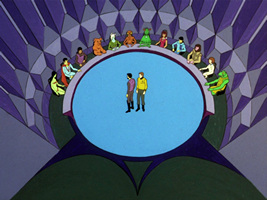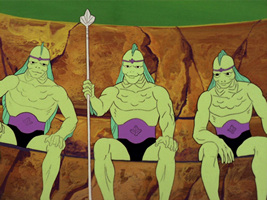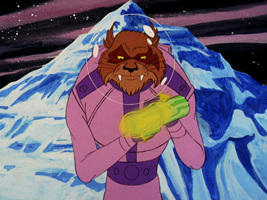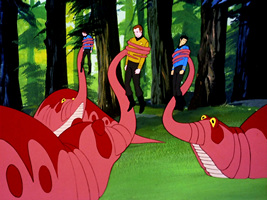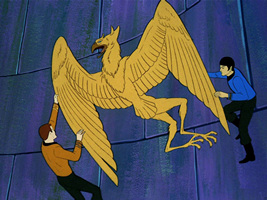The Animated Series (TAS) Season 1 Guest Reviews
Season 1Season 2
Beyond the Farthest Star
Synopsis
Stardate 5521.3: Synopsis in main TAS listing
Commentary
This episode is a promising initial outing for Star Trek: The Animated Series highlighting some of the medium's strengths and weaknesses. Although designed as a children's cartoon, the episode is more serious than comedic. The plot rather successfully shifts from crisis to mystery and back to crisis again before its resolution. Nevertheless, despite the 24-minute run time, the pacing always seems a little slow, perhaps because of the relatively cheap animation style.
The design of the ancient alien vessel is impressive and represents the kind of model and sets that would have been prohibitively expensive in the live-action original series. It was nice that every part of the vessel had organic design touches and yet no one was tempted to say the cliché Star Trek line: "It's like nothing I've ever seen before, it's almost as if the ship had been organically grown rather than built." The episode includes the debut of "life support belts" which allow the landing party to experience hostile environmental conditions without space suits. These would have been a welcome addition to the roster of standard Star Trek equipment, but they were not continued in later series.
When the landing party finds themselves locked in the alien control room, under imminent attack by whatever creature killed the ancient crew, the tension mounts nicely. As Kirk and Spock try to revive the ancient captain's log and warning, the episode becomes quite reminiscent of TNG's "Booby Trap," which may have taken this episode as one of its sources of inspiration. It is only in the final act when the malevolent alien is revealed to be an energy being which immediately takes possession of the Enterprise and its computer that the story becomes stale: we have seen this plot device one too many times in TOS - the alien's impotent voice even sounds reminiscent of Rejack's from "Wolf in the Fold." Kirk's solution of bluffing the entity into departing the Enterprise by pretending he will destroy it is likewise cliché.
Annotations
- Remarkable quote: "Danger! Danger! The dead star... we are being drawn to it! Rather than carry this malevolent life form to other worlds, we have decided to destroy our own ship! There is no other answer! If you understand this message, you are protected only for this moment in this room! This thing, it wants..." (Warning of the long-dead captain, later echoed in the log entries of TNG: "Booby Trap").
- Remarkable technology: The life support belt was an interesting alternative to the haphazard array of space suits that are occasionally featured Star Trek series.
Rating: 5 (John Hamer)
Yesteryear
Synopsis
Stardate 5373.4: Synopsis in main TAS listing
Commentary
"Yesteryear" is the one TAS episode the puts all other TAS episodes to shame, and many TOS episodes as well. Not only does the story provide a nice background on Spock, the time travel aspect is fantastic and, in my opinion, was more intelligently thought out compared to most other time travel stories in Star Trek. I like the idea of Spock barely remembering a man named Selek from his childhood, and then to eventually travel back in time and actually fill that role. This paradox is similar to the one in TNG "Time's Arrow", however the paradox there is not quite as well thought out. What event caused the Enterprise to find Data's head and get involved in the whole time loop? Was it the chicken or the egg? In "Yesteryear" the time loop does not have the "chicken or the egg" problem, or at least it is not as apparent. Since Spock's memory of his childhood is not clear, Selek could have been some other Vulcan man.
It is surprising how well this story fits in with the rest of Star Trek while so many other TAS episodes are hard to take seriously. With the Vulcan forge and the Andorian officer, "Yesteryear" reminded me a lot of the fourth season of Enterprise (the GOOD season of Enterprise). I especially enjoyed seeing the Andorian Thelin give Spock the Vulcan hand sign. This gave me that nice warm feeling of unity and racial tolerance that I always enjoy in Star Trek.
Annotations
- Remarkable pet: Spock's pet sehlat is the first one we see on screen, and the only tame one. We see only one other sehlat in ENT "The Forge".
Rating: 8 (Chris)
Yesteryear
Synopsis
Stardate 5373.4: Synopsis in main TAS listing
Commentary
"Yesteryear" begins with a welcome return to the "planet of the time vortex" that houses the Guardian of Forever (TOS "The City on the Edge of Forever"). We quickly learn that in the time since the Guardian's discovery, the Federation has begun using it for historical research and we see a number of scientists making recordings of Vulcan's recent history, including a member of an avian species (illustrating that more exotic aliens were possible in TAS than in its live-action predecessor).
Meanwhile, Kirk and Spock have traveled through the Guardian to observe ancient Orion history. However, upon their return, they discover that no one recognizes Spock. History has been rewritten and in the now altered timeline, an Andorian named Thelin is first officer of the Enterprise. Research into the new timeline's historical records indicates that Spock died in childhood on Vulcan.
From this information and Spock's memory, it is surmised that adult Spock had originally traveled to the past where he saved his younger self's life, but that the recent use of the Guardian - a combination of Spock being in Orion's past while the historians were taping Vulcan's past - has altered that history. This makes no sense as there's no particular reason why being in Orion's ancient history prevented Spock being in Vulcan's recent history; and, of course, prior to this episode, he hadn't traveled to Vulcan's past at all - even though that intervention was apparently necessary for him to live to adulthood in the first place. (The time change also contradicts the previously established operations of the Guardian; in the original episode, people on the time planet were shielded from the effects of the intervention, but in "Yesteryear" the Federation scientists on the planet are altered along with the rest of the timeline.)
This gaping hole aside, the problem sets up the best conceived story in TAS, as it is decided that Spock must return to the Vulcan of his childhood to correct the timeline. While in past he visits his home town of ShiKahr, beautifully animated, and meets his parents (the voice of Sarek reprised by Mark Leonard). We also see young Spock and the difficulties he has fitting in with a group of young Vulcan bullies, whose teasing seems anything but logical. The background here fits perfectly with Spock's backstory as established in TOS "Amok Time" and "Journey to Babel" and further rounds out our sense of Vulcan culture, at the time the most developed alien race in Star Trek.
Annotations
- Remarkable continuity: ShiKahr is later pictured in the remastered version of TOS "Amok Time."
Rating: 8 (John Hamer)
One of Our Planets Is Missing
Synopsis
Stardate 5371.3: An extragalactic cosmic cloud has entered Federation space at the Pallas 14 system. After consuming the uninhabited planet Alondra, it sets its sights on Mantilles, a Federation colony with a population of 82 million. The Enterprise intercepts the cloud and determines that it is a sentient lifeform. After establishing communication, the cosmic cloud agrees to reverse course and leave the galaxy, saving Mantilles and its inhabitants.
Commentary
TOS: "The Changeling" is often cited as the template for "Star Trek: The Motion Picture." And certainly the basic premise of a damaged Earth-probe, rebuilt by aliens, returning home to find its "creator" is the same. Likewise both Nomad and V'ger identify humans as imperfect "carbon units," discount the possibility that a carbon unit might have created them, and instead imagine (and vainly seek) a creator in their own perfect, mechanical image. However, the similarities almost end there. In "The Changeling," Nomad's origin is known early on; in ST:TMP, the realization that "V'ger" is actually the earth probe "Voyager 6" is only revealed at the end. Much of the tension in "The Changeling" surrounds the fact that Nomad has inaccurately identified Kirk as its creator; whereas the suspense in ST:TMP relies on exploring the mystery of V'ger: an enormous cloud that has destroyed ships, bases, and threatens to destroy the Earth itself.
In this and many other ways, "One of Our Planets Is Missing" is a much more obvious template for ST:TMP. We begin with a mysterious, "cosmic cloud" entering Federation space at a point where the Enterprise is the only starship in interception range. The cosmic cloud is immense: 800,000 km across (V'ger's cloud is even larger). It is observed enveloping and consuming an entire planet and then changing course to seek out additional planets. Just as V'ger's cloud is invulnerable to photo torpedoes, the Enterprise's phasers have no effect on the cosmic cloud.
As with V'ger's cloud, the Enterprise enters the cosmic cloud and finds an elaborate interior structure. As with V'ger, a breakthrough in communication is made with Spock attempts a mindmeld with the cosmic cloud. The mindmeld reveals that the cloud is an extragalactic, intelligent lifeform, which had never imagined beings as small as humanoids could develop sentience. Initially, Kirk resolves to save the population of Mantilles even if it means killing the cosmic cloud. However, successful communication saves both as the cloud is persuaded not to consume Mantilles or any of the inhabited planets in our galaxy. In this way, the episode's happy ending is also more in line with ST:TMP than TOS: "The Changeling," which ends with yet another example of Kirk talking a self-aware computer into committing suicide.
While the Enterprise is unraveling the mystery of the cosmic cloud in the foreground, in the background are the millions of inhabitants on the Federation colony of Mantilles, who lack the time or ships to evacuate more than a token number of children. The planet is governed by Bob Wesley (previously seen as commander of the USS Lexington in TOS: "The Ultimate Computer"), who acquits himself as a remarkably thoughtful and sound leader.
"One of Our Planets Is Missing" remains suspenseful throughout, which in part occurs because its had only 23 minutes to tell a story that dragged out over 2 hours in ST:TMP.
Annotations
- Recycled premise: In some ways the cosmic cloud recycles the premise of the giant space amoeba in TOS: "The Immunity Syndrome," which was itself surrounded by a negative energy "zone of darkness." Whereas the crew end up killing the space amoeba, the fact that they decide to communicate and negotiate with the cosmic cloud is ultimately a better "Star Trek" message. Voyager encounters a cloud-like space-dwelling creature that consumes ships in VOY: "Bliss," and encounters a nebula-like nucleogenic cloud being in VOY: "The Cloud."
- Remarkable colony: Although on the edge of Federation space, Mantilles has a population of 82 million, suggesting that it has already been established as a successful colony for generations.
- Remarkable setting: As they are restoring the ship's anti-matter reserves, Captain Kirk and Mr Scott enter an area of engineering that Scotty refers to as the "anti-matter nacelle." The space is open and cylindrical, approximately 5 decks tall and very much longer. Inside are giant, energy injection tubes (warp coils?). It seems possible that this was meant to be the inside of one of the warp nacelles.
- Remarkable trope: The cosmic cloud is from a different galaxy, just like the space amoeba (TOS: "The Immunity Syndrome"), the planet killer (TOS: "The Doomsday Machine"), Korob and Sylvia (TOS: "Catspaw"), and Planet Mudd's androids (TOS: "I, Mudd"). It's very clear the writers of early Star Trek had no concept of extragalactic distance, the only exception being TOS: "By Any Other Name," where the Kelvans understood that it would take thousands of years at maximum warp to reach their home galaxy of Andromeda.
Rating: 7 (John Hamer)
The Lorelei Signal
Synopsis
Stardate 5483.7: While investigating an area of space where past spaceships have been lost on an incredibly precise schedule (once every 27.346 star years) for over a century, the Enterprise intercepts a powerful signal from the Taurean system. The signal causes audio-visual hallucinations in all the male crew members, generally numbing their minds, and seducing them to approach and orbit Taurean II. The planet once housed a vast, impressive population, but upon beaming down, Kirk, Spock, McCoy, and Ensign Carver discover, only tiny remnant remain --- all of whom are elegant humanoid women. Although the men are dazzled by the beauty of their surroundings, they quickly weaken and begin to rapidly age. Back on the ship, Lt Uhura discovers how the signal works with the help of Nurse Chapel. Assuming command of the Enterprise, Uhura orders Lt Davis to organize an all-female security detail to guard the ship's transporters, preventing any more men from beaming down. Beaming down to the planet, the Enterprise women quickly overpower the Taureans. The Enterprise men are rescued and restored by novel use of the transporter.
Commentary
Lt Uhura takes command of the Enterprise and saves the day with the help of Nurse Chapel and an all-female security team. That summary by itself is almost enough to forgive the many other flaws of "The Lorelei Signal." Early Star Trek wanted to be more progressive regarding gender equality than it ever achieved. After the studio downgraded Majel Barrett from the ship's First Officer in the original pilot ("The Cage") to the ship's nurse, Lt Uhura was the only female member of the primary cast on the TOS bridge crew. Unfortunately, a similar dynamic occurred when Denise Crosby left "The Next Generation" during its first season. Tasha Yar had been the only female role written counter-type. The remaining TNG leads Beverly Crusher and Deanna Troi were portrayed in more traditional nurturing roles of doctor and counselor, as well as mother and former lover.
In many ways, Lt Uhura never got her due. Aside from the few occasions where bad writing marginalized her with gender stereotypes ("captain, I'm frightened"), she was nearly always a self-confident, competent member of the command crew --- played convincingly by Nichelle Nichols. And yet how brief are the moments she was ever allowed to shine! TOS focused on Kirk, Spock, and McCoy. Occasionally Mr Scott broke thru with an episode (and he had his swan song in TNG: "Relics"). For the rest, Sulu eventually got to captain the Excelsior (ST6:TUDC and VOY: "Flashback") and Chekov was at least First Officer of the Reliant during Star Trek's best feature film outing (ST2:TWOK). What about Uhura? I can't banish from my mind the indignity of ST5:TFF.
Like Sulu, Uhura deserved a command. "The Lorelei Signal" is the only time she got one. And in this case, she had to take command entirely on her own initiative, explicitly explaining in the ship's log that she understood she might have to answer for the consequences of her actions. As we might expect, she does a good job and saves the day. Unfortunately, some of her success is undercut by Spock's desperate message to order an all-female emergency rescue, and later his order that a female engineer needed to route 100% of the ship's power into the shields to block the Lorelei signal. Since Spock so frequently has the limelight and saves the day, I would have much preferred to see Uhura take the initiative on one or both solutions.
The rest of the episode is fairly cliché. Taurean II has an all-female society built on the ancient myth of the sirens. Moreover, the women (against their will) have traded the ability to give birth for immortality and eternal beauty. But to pay for their longevity, they are forced to drain the life force out of men they lure to their planet. If the rest of the episode is winning awards for gender equality, these tropes seem dismally sexist. To illustrate my point, the planet's leader Theela uses the title "Head Female." And since the aliens have an all-female society, their technology (including the "opto-aud" computer) is operated harmonically by singing. All I can say is: at least it's not Angel One.
Annotations
- Remarkable dialogue: "What are you doing?!" - "Taking command of this ship!" (Nurse Chapel and Lt Uhura)
- Remarkable technology: For the first time in Star Trek, a person's pattern recorded by the ship's computer, is used to correct the effects of a massive deterioration of their body. Nurse Chapel exclaims, "This has never been done before!" and Spock estimates the odds against it working as 99.7 to 1. However, once this convenient method is established, it's difficult for the writers to avoid. For example, Dr Pulaski's rapid aging is later reversed using the transporter in TNG: "Unnatural Selection." Likewise, the youthened Enterprise crew were restored to their normal ages in both TAS: "The Counter-Clock Incident" and TNG: "Rascals." Ultimately, this technique should theoretically be able to cure almost all injury or illness in the Federation and would function as a way to achieve practical immortality. But where would the fun in that be?
- Nitpicking:
- Kirk, McCoy, and Carver are hiding in a giant urn. The Taurean women search everywhere and can't find them. However, Lt Uhura asks if their "opto-aud" computer can reveal their location, which it promptly does. Now why didn't the Taurean women think of that before?
- While Kirk notes that previous spaceships have been lost at a precise interval (once every 27.346 star years), he indicates much more vaguely that this has been going on for 150 years. But "150 years" doesn't work mathematically. If the interval is precise, disappearances have either happened 5 times over the past 136.73 years or 6 times over the past 164.076 years. However, the fact that the historical record has been pieced together during recent talks between the Federation, Klingons, and Romulans, is an interesting bit of information.
Rating: 4 (John Hamer)
More Tribbles, More Troubles
Synopsis
Stardate 5392.4: In a direct sequel to TOS: "The Trouble with Tribbles," the Enterprise is escorting two robotic ships carrying grain to Sherman's Planet. They encounter the Klingon battlecruiser Devisor chasing a scout ship registered with the Federation. As Klingons destroy the scout ship, the Enterprise beams aboard its captain and cargo: Cyrano Jones with a large number of tribbles. Jones has genetically altered the tribbles to make them "safe" pets. In addition, he has a predator called a "glommer" that eats tribbles. Klingon Commander Koloth claims that Jones is responsible for causing an ecological disaster on one of their worlds and demands the Enterprise surrender him. Kirk reluctantly refuses because he notes (regrettably) that Jones is a Federation citizen. The Klingons attacks using a new statis-field weapon, which immobilizes the Enterprise, but leaves the Klingons similarly unable to act. Kirk directs the robot grain ships to ram the Devisor, causing the Klingons to break off their attack. After more engagements lead to stalemate, Koloth admits that the Klingons only want to recover the glommer which they genetically engineered to rid their planets of a terrible tribble infestation. In the meantime, it's also learned that Jones' genetic modifications to the tribbles were flawed: they continue to have a hyper-metabolism which causes them to grow to enormous size. Dr. McCoy is able to synthesize a cure that causes the giant tribbles to break apart into their normal-sized constituents, which are finally judged to be safe pets for happy Federation children everywhere.
Commentary
I'm a life-long Star Trek fan and I'm writing this review in 2020 at age 50. I think I'm one of the rare people who actually became a fan of the franchise starting with Star Trek: The Animated series, which debuted in 1973 when I was 3 years old. "More Tribbles, More Troubles" is an episode I remember seeing when I was 3 or 4 -- one of my earliest memories of television or anything else.
From TAS, I became a fan of TOS in syndication, watching all of the episodes over and over again in syndication. "Star Trek II" came out in 1982 when I was 12. I probably watched or listened to it as many as 100 times on video and audio tape, and I still have most of the words memorized: "Gishu morla, ik banu." - "Qua pria pleek, mon ooklam?" - "Ish beni, Komin!" - "Klingaas lami bafek, Saavikam." (dialogue in Vulcan from "Star Trek II" between Spock and Saavik, written out just now from memory.*) Star Trek: The Next Generation debuted when I was 17 and ready for a more sophisticated series. Star Trek has always been a part of my life, and in some ways, Star Trek grew up with me as I grew up with Star Trek.
Returning to TAS is therefore like returning to my own childhood. "The Trouble with Tribbles" is one of the most beloved -- and best and funniest and most memorable -- episodes of the original series. That's not an easy feat to pull off. It's one thing for a love tragedy like "The City on the Edge of Forever" to rank so high or an action-packed thriller like "Balance of Terror." It's much more difficult and for a comedic romp to fire on every cylinder, but "The Trouble with Tribbles" pulled it off. The episode was ripe for a sequel, and Deep Space Nine's sequel "Trials and Tribble-ations" ended up being one of the best outings of the series.
TAS: "More Tribbles, More Troubles" is a much less successful sequel, despite being written by David Gerrold (who penned the original) and return of Stanley Adams as Cyrano Jones. Nevertheless, as I rewatched it to review, "More Tribbles, More Troubles" is not as bad as I feared, given its generally negative reputation.
In the first place, this is a rare, early example of starship combat in Star Trek, akin to the duel between the Enterprise and the Romulan bird-of-prey in TOS: "The Balance of Terror." Once more, we have asymmetric warfare. The Klingons have a new weapon that can immobilized the Enterprise, but maintaining it completely drains their power, preventing them from exploiting their advantage. Meanwhile, the Enterprise has control of two robotic grain ships that can be operated remotely even while caught in the Klingon's field. In their first encounter, Koloth disables one of the robotic ships before being forced to retreat due to energy depletion.
When Koloth's ship has fully recharged, he returns to the melee. Kirk plans to use the same tactic again, but instead of using his new weapon to immobilize the Enterprise, Koloth attacks and disables the second robotic ship. This is a brilliant strategy, which Kirk failed to anticipate -- effectively the opposite result of the duel in "The Balance of Terror." With both robotic ships immobilized, the Enterprise is again susceptible to the Klingon weapon. However, at this point Kirk makes use of the same ploy Scotty used in "The Trouble with Tribbles," beaming tribbles to the Klingon ship. Left with no alternative, Koloth admits that his only concern is recover of the glommer -- which the Klingons desperately need to fight tribble infestations on their worlds. After the Klingons come clean, Kirk decides to return their stolen property.
*I looked it up just now and the dialogue as written is: "Gishen worla ihk-banut." - "Wakli ak'wikman - ot-lan?" - "Ish-veh ni... komihn." - "Kling akhlami buhfik -- Saavik-kam."
Annotations
- Remarkable continuity: At the end of "More Tribbles, More Troubles," McCoy's procedure has finally created a "safe" tribble. Although TAS is sometimes not considered canon, safe tribbles later appear in "Star Trek III: The Search for Spock," and they exist as pets on the Enterprise-D in "Star Trek: Generations."
Rating: 4 (John Hamer)
The Survivor
Synopsis
Stardate 5143.3: Responding to a distress signal, the Enterprise recovers a disabled civilian scout ship, apparently piloted by famed Federation philanthropist Carter Winston, who has been missing for five years. Although the survivor gives every appearance of being Winston, he is revealed to be a Vendorian shape-shifter. Operating as an agent of the Romulans, the Vendorian assaults Kirk, assumes his identity and orders the Enterprise into the Neutral Zone. Before the ship is seized by a Romulan battle group, the Vendorian switches sides, allowing the Enterprise to escape to safety in Federation space.
Commentary
How many fiancés of lost Federation celebrities is the Enterprise carting around? Is it just the two ladies who are seemingly reunited with their loves* (Nurse Chapel and Lt Anne Nored)? Or is it possible that there are another half dozen lonely ladies on board whose lost fiancés never turned up at all?
The setup of "The Survivor" too closely mirrors "What Are Little Girls Made Of?" to be sensible. Like Dr Roger Korby, Carter Winston is famous across the Federation. Both go missing. Both their fiancés are members of the Enterprise crew. And in both cases, the Enterprise encounters creatures who have assumed their identity: in Dr Korby's case, an android replica, and in Carter Winston's case, a Vendorian shape-shifter. (We might mention that a third doppelganger had previously assumed the identity of an old girlfriend of Dr McCoy in TOS: "The Man Trap").
There are a number of shape-shifting species in Star Trek with different degrees of supernatural powers. At the weak end is the "salt vampire" (TOS: "The Man Trap") whose shape-shifting is illusory, appears to be limited to forms of approximately humanoid size, and who doesn't necessarily gain the imitated form's strength or abilities. Antosian "cellular metamorphosis" alters the physical form without significantly changing size or mass (TOS: "Whom Gods Destroy") which is similar to the abilities of Chameloids (ST6:TUC). More powerful were the Allasomorphs of Dalled IV who can assume forms that vary in size and strength (TNG: "The Dauphin"). Most powerful of all are the Founders who rule the Gamma Quadrant's Dominion. The Founders can shrink to the size of a mouse (DS9: "Crossfire") or become a giant space-faring, warp-capable being (DS9: "Chimera"). Although the Vendorians are limited to rearranging their molecular structure to "anything of the same general size and mass," as Spock confirms, that still puts them closer to a Founder than a Chameloid.
The particular Vendorian in "The Survivor" admits that "among my own people, I'm a non-producer, useless, an outcast fit only to do those tasks of the lowest order." Nevertheless, he is able to mimic a human so convincingly that his own fiancé is fooled and the Enterprise's most detailed medical scans produce only inconclusive anomalies. In his natural form, he can physically outfight Kirk, Spock, and McCoy together. His transformational abilities aren't limited to living beings, as he assumes the form of an inanimate bio-bed. Most remarkable of all, the Vendorian is able to take the form of a starship's deflector shield and successfully absorbs Romulan disruptor fire without sustaining any damage himself! It's little wonder that the Federation quarantines their planet, especially in light of their cultural proclivity to "practice deceit as a way of life," as Spock puts it.
Given the Vendorian's abilities, the Enterprise crew should have been totally helpless to find or defeat him. However, he makes a number of reckless and even stupid moves --- for example, resuming the form of Carter Winston --- perhaps justifying the judgement of the other Vendorians who treat him as an outcast, unfit for meaningful responsibilities.
Although seizing control of a Constitution class starship (and the Enterprise particularly) has been high on the Romulans' priority list (TOS: "The Deadly Years," "The Enterprise Incident"), their plot here seems to be under-ambitious. If you had recruited an agent who could assume any form without detection, couldn't he be used for some more sophisticated deep espionage in the Federation than simply luring a starship into the Neutral Zone? Perhaps this was simply a first test mission for this Vendorian agent --- a test which he obviously failed.
Lt Nored's reaction to learning that the being she thought was Carter was an imposter is a surprising contrast to Nurse Chapel's realization that the Roger she'd recovered was actually just an android. Both Nored and Captain Kirk are surprisingly forgiving of an alien who deceived, attacked, impersonated, and attempted to betray them to the Romulans. This might be chalked up to the brief format of TAS, but the resolution as presented doesn't seem credible.
*Actually both are reunited with doppelgangers.
Annotations
- Remarkable family member: Dr McCoy mentions his daughter who was a student on Cerberus during a crop failure when the colony's population was saved by Carter Winston. This is our only canonical mention of Joanna McCoy, who was originally intended to be the main character of the episode TOS: "The Way to Eden".
- Remarkable guest star: The Vendorian is voiced by Ted Knight, famous for his role as Ted Baxter in "The Mary Tyler Moore Show." While Knight would otherwise be a good casting choice, his voice is so similar to Shatner's, I almost could have imagined it was Shatner doing a Ted Knight impression.
- Remarkable continuity: We meet a second Vendorian on Tulgana IV in Loer Decks: "Envoys," which helps establish to my satisfaction that TAS is at least as canonical as ST:LD, ST:PIC, and ST:ENT, and perhaps a bit more canonical than ST:DIS and the Abramsverse movies.
Rating: 3 (John Hamer)
The Infinite Vulcan
Synopsis
Stardate 5554.4: The Enterprise is exploring Phylos, a world where plant-life has developed intelligence and a sophisticated technology. In the past generation, Dr. Stavos Keniclius 5, a giant clone of a human scientist from the Eugenics Wars, introduced a disease that nearly wiped out the local Phylosian population. Having also provided the cure, the few remaining Phylosians now follow Keniclius' orders. They kidnap Mr. Spock, whom Keniclius clones in order to produce his idea of the universal superman. In the process of creating the first of these, the giant clone "Spock 2," Keniclius has sapped the original Mr. Spock's mind and life force. But Kirk convinces the clone that his only ethical choice is to save his predecessor, which he does using a mind-meld. Spock 2 remains on the planet with Keniclius to help the Phylosians rebuild their society, which is assumed will join the Federation.
Commentary
If you begin with the shorthand, "the one with the giant Spock clone" - you might imagine this episode is so dumb it should be instantly dismissed. It's definitely a train-wreck, but it's not for lack of ideas and themes. If anything, it's because it's filled with too many ideas to explore in 23 minutes.
Let's begin instead by noting that this is a very rare episode where Mr. Sulu gets significant screen time in the A-plot and Uhura takes the lead in the B-plot. Beginning with TNG, Star Trek became an ensemble series. There are Troi episodes, Geordi episodes, Dr Crusher episodes, Worf episodes, Wesley episodes, etc. But TOS, TAS, and the classic movies of the original cast are not ensemble shows: they are predominantly Kirk/Spock/McCoy shows where the supporting cast rarely emerges beyond bit parts.
Even in their send-off feature, "Star Trek VI: The Undiscovered Country," the tribute scenes planned to show what Scotty, Sulu, Uhura, and Chekov had been up to were cut for reasons of time and budget. Although TOS crossed important thresholds by having an Asian American man and an African American woman in leadership roles, the show's development of Sulu and Uhura was unfortunately limited. Originally both George Takei and Nichelle Nichols were going to be cut from the TAS cast to save money before Leonard Nimoy famously went to bat for them to say he wouldn't be involved without them. (Walter Koenig's character Chekov did get cut from TAS, but the actor made his way into the series here as the episode's writer.)
Mr. Sulu's interest in botany was established in several TOS episodes including "The Man Trap," where he was cultivating a carnivorous plant, whom he called Gertrude. On Phylos, Sulu discovers the fact that the retlaw plants are mobile. When he's later poisoned by one of the retlaws, the sentient Phylosians reveal themselves in order to heal him. Because Mr. Spock spends much of the episode kidnapped off-screen, Sulu takes on most of the tasks like scanning that would have gone to Spock. Even the concluding "humorous" banter this outing is between Kirk and Sulu, although its meaning remains inscrutable.
Although the idea of sentient plants has potential, it's unfortunately not developed. There's really nothing plant-specific about the Phylosians, other than their susceptibility to Dr. McCoy's grandpa's weed spray. They could have just as easily been lobster people as asparagus people.
The treatment of cloning is worse in the it makes no sense. Why are the clones giant? Why should a racist human scientist from the Eugenics Wars find a human/Vulcan hybrid to be the universal superman? Why does Keniclius need to kill the original Mr. Spock to make his duplicates? That's specifically not how cloning works as Kirk himself states, "incredible that a man could take a few cells from his body and reproduce himself time after time." None of these threads are well explained and all of the ideas taken together form a muddle.
Fortunately, the wrap-up is swift as Kirk quickly reasons with the giant Spock-2 clone, who not only saves the original Mr. Spock, he dissuades Keniclius and the Phylosians of the centuries' long ambition to forcibly become the galaxy's self-appointed peacekeepers. In the end, Kirk decides to leave them all to themselves on the planet with their giant war fleet intact. What could go wrong?
Annotations
- Remarkable analogy: In talking about Keniclius' search for a genetic super-man to clone, Dr McCoy calls him "a modern Diogenes" without explaining further. For a children's cartoon, this is a bizarre mixture of erudition and ignorance. The writers presume that the viewer is familiar with the famous story of Diogenes holding up a lantern in broad daylight and, on being challenged as to why he'd do such a thing, explaining that he was "looking for an honest man." At the same time, the writers are totally unaware of Diogenes' actual intent. Diogenes was a leading proponent of the ancient philosophy of cynicism. His lantern stunt was part of a repertoire of performance art designed to jar Athenians out of their complacency. Comparing Diogenes' lantern to Keniclius' racist, eugenic quest to find a superman to clone is absurd.
Rating: 4 (John Hamer)
The Magicks of Megas-Tu
Synopsis
Stardate 1254.4: On a scientific mission to explore the galactic core, the Enterprise encounters a place where matter itself is being created. Pulled into a galactic vortex, the ship is drawn into a dimension where the normal laws of physics do not apply. Instead everything operates by magic fueled by a combination of individual beliefs and drawing pentagrams. At the heart of this dimension is the planet Megas-Tu, inhabited by the Megans. In the past, the Megans traveled to Earth where they were mistaken for demons, warlocks, and witches. Many were apparently killed in the Salem witch trials in colonial Massachusetts before the survivors made their way back to their home dimension. The Megans put the Enterprise crew on trial for humanity's crimes, ultimately ruling that the species had improved sufficiently for the crew to be released.
Commentary
In one of the more cringe-worthy outings of TAS, "The Magicks of Megas-Tu" combines a number of elements previously explored by the franchise in TOS. We've already dabbled in magic and witchcraft in the deplorable "Catspaw." Kirk and the crew were already put in an archaic trial by energy beings in "The Squire of Gothos." And we've already had ancient alien astronauts who visited Earth's past and posed as gods in "Who Mourns for Adonais?" Finally, Lucien appearing on the viewscreen reminded me of nothing so much as the appearance of Abraham Lincoln in "The Savage Curtain."
Star Trek includes far too many alien beings who once visited Earth's past. In TOS alone, we were introduced to Apollo who visited ancient Greece with his companions ("Who Mourns for Adonais?"), to the Platonians who likewise visited ancient Greece ("Plato's Stepchildren"), and we were given evidence of the Preservers visiting Earth c. 1400 AD ("The Paradise Syndrome") and unnamed aliens who visited Earth to abduct Gary 7's ancestors c. 4000 BC ("Assignment: Earth"). Unfortunately, the Megans do not end this trend. We will meet additional ancient astronauts in TAS, TNG, DS9, VOY, and ENT.
This time, the ancient astronauts are magic-users who call themselves the "Megans." They came from a dimension where normal physical laws do not apply, but where "magic" works instead. They arrived on Earth at some time in the distant past and lived among humans until the famous Salem witch trials in the 1690s, when many Megans were burned as witches and the rest finally fled home to Megas-Tu. The Megans inhabit a magical realm where thought and reality are not separated by fixed boundaries. Nevertheless, they manage to create a society filled with mundane professions and transactions. As Lucien explains in his best used-car salesman voice, "Do you need a room, a stable, a castle? Stop in at your friendly sorcerer/contractor. Let him do the work."
Much of "The Magicks of Megas-Tu" is echoed by the crew meeting "God" at the center of the galaxy (ST5:TFF) and the first and worst encounters with Q (TNG: "Encounter at Farpoint," "Hide and Q"). Although the TAS episode came first, if anything it's even duller, and even more filled with senseless exposition than these attempts to re-use its premise.
Annotations
- Remarkable (dis)continuity: Just as in "Star Trek V: The Final Frontier," without any explanation given, the Enterprise is able to easily travel to the center of our galaxy and back (a journey of over 50,000 light years, which is more than 2/3rds the distance the USS Voyager needed to travel to get back home from the Delta Quadrant). Also coincidentally, the Enterprise finds a being pretending to be "God" in ST5:TFF, and finds the Devil in this episode.
- Nitpicking: Although Captain Kirk explicitly states in his log that the Enterprise is on a "science mission" during this episode, "The Magicks of Megas-Tu" has nothing to do with science. The Enterprise has somehow traveled to the galactic core to survey evidence that the Milky Way was originally formed by an explosion and to see whether "the center of the galaxy might still be creating new matter." This an absurd proposition completely unrelated any theory of galaxy formation that I'm aware of. The writers appear to be confusing the formation of our galaxy with the origin of the universe in the Big Bang. This seems to be confirmed when the Enterprise reaches the center of a galactic vortex and Spock announces that they will be going "through the center of things... through what may be the center of everything." The center of our galaxy is no more the center of the universe than is our sun (as theorized by Copernicus) or the earth (as developed by Ptolemy). This is something that was well known in 1973. All this is relevant because "Star Trek: The Animated Series" was a children's television show and if it is going to label something as an actual scientific theory, the writers should research the science. Unfortunately, the episode goes down hill from this initial low point, moving on from bad science to outright magic mixed with a misreading of Earth history.
- Nitpicking: The name Asmodeus comes from ancient Avestan "aeshma-daeva" meaning "wrath demon." This demon was part of Zoroastrian religion some 3,000 years before the Salem witch trials. Are we to assume the Megans were on Earth for 3,000 years, influencing the creation of Judaism, Christianity, and Islam, and yet after all that time, they understood humans so poorly and they were so generally powerless that they were taken into custody and executed by a handful of English colonists in such an amazingly unimportant place as Salem?
- Remarkable dialogue: McCoy: "Do you think Lucien really was the demon some me call 'Lucifer'?" - Kirk: "Does it matter, Bones?" - Spock: "It just might, captain. If he was, this would be the second time Lucifer was cast out, and thanks to you, the first time he was saved."
- Remarkable stardate: The stardate given for this episode "1254.4" is lower than any other stardate given in TAS or TOS.
Rating: 1 (John Hamer)
Once Upon a Planet
Synopsis
Stardate 5591.2: The Enterprise returns to the "so-called Shore Leave Planet" located in the Omicron Delta region. The planet's facilities were designed to fabricate fantasy settings and robots programmed to fulfill the wishes of any visitor. Although these scenarios previously proved dangerous, the Enterprise crew believe they now understand the rules and will be safe this second visit. This expectation is quickly dashed when the Queen of Hearts and her troops (from Lewis Carol's Alice: Through the Looking Glass) appear and attempt to relieve Dr McCoy of his head. An emergency beam-out recovers all the members of the landing parties except Lt Uhura, who is captured by robots and taken beneath the planet's surface. Upon further exploration, the crew realize that the planet's "Keeper," whom they met on the previous visit, has passed away, leaving the central computer to its own devices. Having jumped to several erroneous conclusions, the computer wants to seize the Enterprise to travel the galaxy. However, Kirk talks the computer out of its plans and convinces it to continue its role providing hospitality to visiting aliens.
Commentary
One of the failings of "Star Trek: The Animated Series" is indulging in direct sequels that lack any new ideas. "I, Mudd" served was a sequel to "Mudd's Women," but it added the entirely new plot element of a planet of androids. "Mudd's Passion," by contrast, is a tired rehash of "Mudd's Women." The same is true for "More Tribbles, More Troubles," the sequel to "The Trouble with Tribbles," and "Once Upon a Planet," the sequel to "Shore Leave."
The original "Shore Leave" was campy and quirky. It wasn't an amazing outing, but it wasn't terrible. The set-up: a planet where a person's fantasies are immediately realized with just a thought, in theory should be a playground for the imagination of the writers. This should be even more true in the animated series, where production isn't limited by the need to build actual props. Unfortunately, both outings show that the writers didn't have much imagination.
In "Shore Leave," the audience is clued into the fact that something is seriously wrong in the teaser where Dr McCoy encounters a creature out of pure fantasy: the white rabbit from "Alice in Wonderland." It would have made more sense to have more normal encounters, which get ever more fanciful as the mystery unfolds. In the sequel, "Once Upon a Planet," we already know the mystery: the planet reads your thoughts and manufactures robots and buildings to fulfill them. However, the new twist is that the planet's computer no longer wants to host guests but has a new agenda. It would have made sense for that new mystery to unfold slowly as the crew's fantasies are fulfilled in ways that are increasingly off from their desires. Instead, the writers jump immediately to the Queen of Hearts yelling "off with their heads!" Once again, this prematurely clues the audience into the fact that something is seriously wrong.
Following one of the most common tropes in TOS, we have a computer controlling a planet (cf. "Return of the Archons," "The Apple," "That Which Survives"). The computer is operating from bad information (similar to Nomad in "The Changeling"), but in this case there's no explanation of where the Shore Leave planet's computer got its misinformation. The implication is that it was content to obey the Keeper while he was alive, but subsequently has started to make all sorts of wild and unwarranted surmises (e.g., starships are "sky machines" whose crews are slaves of the sky machines).
Lt Uhura has a substantial role as she spends most of the episode in the planetary control room attempting to learn about what's going on, what the computer plans, and how to stop it. Unfortunately for her, the computer can read minds and prevents her from implementing her plans. Meanwhile, a landing party consisting of Kirk, Spock, McCoy, and Sulu fight fantasy creatures as they attempt to penetrate into the planet's subterranean chambers.
Back on the ship, Scotty is left in command and his bridge crew consist of Arex, M'Ress, and an unnamed black helmsman. The Shore Leave computer is attempting to gain control of the ship. It takes control of navigation until Arex cuts in the manual override. The computer then shuts off the artificial gravity which leads to an impressive zero-G sequence that would not have been possible in TOS. The crew solve the issue of floating around helplessly by using seat-belts!
While the action is relatively suspenseful and everyone has something to do, in the end, too much of the episode comes down to talking to computer, which behaves like many computers in TOS, but nothing like computers in real life. The only break from the standard TOS cliché is that Kirk doesn't argue the computer to death, he persuades it to go back to its old job.
Annotations
- Remarkable fantasies: While Uhura sings by the lakeshore and Sulu explores a forest, McCoy conjures up a Southern plantation manor! "They just don't make them like that any more." I should think not, given that the U.S. Civil War had ended slavery just over four centuries earlier. This is a rare, explicit reminder that Dr McCoy's frequent racist remarks against Vulcans in general and Spock in particular are not divorced from his character's history, but are drawn from it.
- Remarkable setting: While serving as the computer's hostage, Lt Uhura is brought to a massive underground control room, which would have required a matte painting in a live action series.
- Remarkable callback: The crew are cornered in a cave by a giant cat reminiscent of the cat in the terrible TOS episode "Catspaw." Why repeat a hokey live-action effect when you can literally draw anything in animation?
- Remarkable picnic: In the end of the episode, Dr McCoy and Mr Sulu are seen having picnic with Alice, the white rabbit, and a previous deadly two-headed dragon.
Rating: 5 (John Hamer)
Mudd's Passion
Synopsis
Stardate 4978.5: The Enterprise captures Harry Mudd who is attempting to sell love crystals to miners on a colony outside of Federation space. While in Nurse Chapel's custody during a medical examination, Mudd takes advantage of the situation by offering to let her experiment with one of the crystals on Mr. Spock. Later he kidnaps Nurse Chapel, steals a shuttle, and escapes with her as a hostage to an unexplored planet inhabited by giant rock monsters. Operating under the effect of the love crystals, Spock insists on beaming down to the planet with Captain Kirk and a landing team to rescue Nurse Chapel. While everyone on the planet tries to fend off the rock monsters, the crew up on the ship becomes infected and experiences the amorous effects of the crystals. Eventually the effect wears off, Nurse Chapel is saved along with the landing party, and Mudd is sent back to a Federation rehabilitation colony.
Commentary
Sometimes TAS episodes masquerade as unfilmed TOS episodes whose ideas find their way into the golden era of TNG, DS9, and VOY. But other times, they live up to the name "The Animated Series," and remind us that these were produced and aired as a children's Saturday morning cartoon. "Mudd's Passion" falls squarely in the latter camp.
Harry Mudd was a popular enough character from TOS to inspire a revival in "Star Trek: Discovery." In fact, the sequel episode, TOS: "I, Mudd" was far superior to the flawed, initial outing, TOS: "Mudd's Women." Since TAS actually had the voice of the original actor (Roger C. Carmel), the ingredients were present for at least a humorous episode. Unfortunately, extremely lazy writing left next to nothing for the actors to work with.
"Mudd's Women" ended with the preposterous reveal that Mudd's "Venus drug" was simply a placebo. "Mudd's Passion" turns this around by revealing that the love crystals that Mudd believes are a fraud, actually work. (They cause intense feelings of love, followed by momentary feelings of hatred, before wearing off with an intense hang-over.) In theory, this is clever. In practice, it's boring.
The plot is nonsensical. One of Starfleet's principal ships is sent outside Federation boundaries to pick up a low-end con artist. Once apprehended, Mudd is turned over to Nurse Chapel for a physical without a single security guard to back her up. Mudd convinces her to betray her duty and try the love crystals out on Spock in way that is reminiscent of Lt. Marla McGivers' betrayal of the ship to Khan (TOS: "Space Seed"). For all Star Trek's promise of progressive messaging, sexist portrayals of female officers as weak links are far too frequent.
Mudd's escape plan is bizarre. Having stolen Nurse Chapel's security badge, he's able to make his way to the shuttle bay without being seen at all (is no one on the ship any more?) On the theoretically uninhabited planet, he hopes to get by on further hustling prior to realizing that rock monsters can't be hustled.
I will say that when Captain Kirk calls for an emergency beam out, and we cut momentarily to the transporter room where a male and female crew member are dancing to elevator music, it's just about the silliest thing in Star Trek. I laughed out loud, but I was laughing at the show, not with it.
All in all, this was a real missed opportunity.
Rating: 3 (John Hamer)
The Terratin Incident
Synopsis
Stardate 5577.3: The Enterprise receives a garbled communication sent using archaic interstat code, of which the only intelligible word is "Terratin." Traveling to the source of the transmission in the Cepheus star system, the ship encounters a planet with a crystalline structure and heavy volcanic activity. On assuming orbit, the Enterprise is blasted by a wave of energy emanating from the planet, that has devastating effects: (1) shattering the ship's dilithium crystals, and (2) causing all organic matter to begin to shrink in size (including the crew). Mr Spock calculates that the crew will effectively lose the ability to operate the ship's switches and controls when they are approximately 1 cm tall, which will occur within 32 minutes. Without power to break orbit, Kirk opts to beam down to the planet in a last ditch effort to find the source of the energy beam. On the surface he encounters a tiny city of lilliputian humans who are revealed to be the lost Earth colony of Terra Ten (now called "Terratin" in the local vernacular). Recent volcanic activity threatens to destroy their city, which forced the Terratins to use their system defense weaponry as the only available means of getting Starfleet's attention. After apologizing for their behavior, the Terratins share their own dilithium crystals to revive the Enterprise's engines. The Enterprise crew are restored to full size using the transporter and Kirk rescues the Terratins, beaming up their entire city and ferrying it to a new planet.
Commentary
While the pacing is often slow and awkward in TAS, everything moved forward quite smoothly in "The Terratin Incident." There's suitable action (e.g., a shrunken Kirk rescues Nurse Chapel from an aquarium using a thread) and none of it feels arbitrary (like the random fights with monsters that dot other TAS outings).
For once, every use is made of the premise as the crew experiences the familiar environment of the ship in an entirely unfamiliar way. At each stage as they shrink, the crew encounter new difficulties. When the engineers are just over a meter tall, they have trouble handling their largest tools. When the crew are under a meter high, Lt Arex can't complete scans since his "eyes no longer fit the opticals" and Lt Uhura reports "I can't reach the dial I turned 5 minutes ago." At about 40 cm tall, Mr Sulu is knocked off his control panel by a dial, causing him to break his leg. Reduced to 20 cm, Kirk and the others are no longer able trigger the electric eye that opens the turbolift door. At the 10 cm, Mr Scott requires a crew of three engineers pulling on strings with all their might to shift the iconic levers of the ship's transporter: "Heave, lads, heave!"
The episode is remarkable for its attempts to provide scientific (or at least Treknological) explanations for the effects of the "spiroid epsilon waves." Special care is given to explain the difference between organic and inorganic matter, the former of which is shrinking, the latter of which remain the same size. For example, the coral in the Sickbay aquarium is organic, but the rock beside it isn't; thus the coral shrinks, while the rock remains the same. Spock notes that everyone's uniforms are made of organic Xenylon, which is why they are fortunately shrinking along with the crew --- unlike the man in the "Incredible Shrinking Man" who needed to fashion new clothing or go naked. (No similar explanation is given for where the giant Spock-2 clone created in TAS: "The Infinite Vulcan" would have gotten a hold of a giant uniform.)
Unfortunately, the two explanations for why this is happening don't really make sense taken together. On the one hand, we're reminded that matter is mostly empty at the atomic level, and we're told that the space between protons and electrons is contracting (which is why everyone's mass remains constant while their size decreases). Even if this were possible, it wouldn't explain why only organic matter is effected. That brings us to the second explanation. We're reminded that organic matter contains DNA, which is a spiral helix molecule that can be contracted a limited degree by being wound tighter. Taken together, this mistakes the atomic and molecular levels and even if DNA can contract, what about the rest of the material in organic cells? Nevertheless, there are two legitimate scientific principles taught here and I feel the episode at least deserves an A for effort.
There is also a bit of good, hard science fiction going on. Normally starships (and landing parties) in the TOS and TAS eras explore potentially dangerous situations without a lot of advance scanning. Before approaching Terratin, Kirk orders a complete check of the effects of radiation Spock has detected. These begin with bridge status reports, sensor reports, and engineering status reports. Kirk then calls Sickbay to find out if any of the sensitive lab animals were affected. We see that the Enterprise carries gossamer mice and halo fish because they immediately register the slightest environmental change.
After the many satisfying adventures of the incredible shrinking crew, Kirk beams down to the planet and discovers that a lost colony of Earth is the cause of the trouble. In TOS: "The Balance of Terror," Spock explains how the Romulans may be lost colonists of Vulcan, saying: "Vulcan, like Earth, had its aggressive, colonizing period; savage, even by Earth standards." Between Zefram Cochrane's invention of warp drive in 2063 ("Star Trek: First Contact") and the foundation of the Federation in 2161, different groups and nations must have launched hundreds of expeditions to colonize class-M planets in the vicinity of Earth.
We know the number of early colonies was substantial for two reasons. The first is the large number of established human colonies that had already achieved populations of more than 1,000,000 by the 2260s, such as Deneva (TOS: "Operation - Annihilate!"). Even with the constant addition of immigrants from Earth, it would take the full two centuries available (at least) to achieve this population demographically. The second reason we know that the number of colonies was very large is that so many ended up getting lost and forgotten.
Examples of lost Earth colonies include Bringloid V and Mariposa (TNG: "Up the Long Ladder"), Moab IV (TNG: "The Masterpiece Society") and, of course, Terratin, originally "Terra Ten." Another example of a lost colony is presented in ENT: "Terra Nova." However, the implication in this episode is not only that Terra Nova was Earth's first extra-solar colony, but that "there weren't any other habitable planets" in range of Earth's early colony ships. Since this statement is wholly at odds with Star Trek's established history, it should be ignored (along with most of ST:ENT) as non-canonical.
Some thought has been given to Terratin culture as it's developed in isolation for centuries. Not only has the planet's name contracted from "Terra Ten" to "Terratin," its leader is known as "the Mendant." Although unexplained, this is possibly a contraction of "Commandant"? The Terratins describe their culture as proud and the Mendant claims not to know how to beg, but in the end is nevertheless gracious and trusting in throwing himself and his people on Kirk's mercy.
The episode was written by Paul Schneider, who previous penned TOS: "The Squire of Gothos" and "The Balance of Terror." The former is the clear inspiration for the TNG's favorite guest character Q, and the latter is my vote for best TOS episode overall. "The Terratin Incident" is easily among the best episodes of Star Trek: The Animated Series and, in my view, fits in among Star Trek's many best outings franchise-wide.
Annotations
- Remarkable obstinacy: As the tools in engineering seem to have become too large to handle, Kirk jumps to the conclusion that "the whole ship is apparently expanding." Spock points out that "an equally good possibility is that the ship's personnel have contracted and may be continuing to shrink." Later, in his log, Kirk clings to his own initial idea saying that the problem is either "a contraction of our bodies or an expansion of the ship by a factor of 0.3." It's only when McCoy's analysis confirms that organic matter is contracting on an atomic level that Kirk concedes, "then Spock's theory is right; we're contracting." I think this a well written example of Kirk's ego and character.
- Remarkable continuity: Terratin has grown volcanically unstable due to large quantities of dilithium in the planet's crust. Vast dilithium deposits were having the same effect on Drema IV in TNG: "Pen Pals."
- Re-used premise: The premise of shrunken Star Fleet officers interacting with the ship was re-used in DS9: "One Little Ship," producing another delightful outing.
- Remarkable Deus ex Machina: Having established that stored patterns in the transporter can correct the effects of aging in TAS: "The Lorelei Signal," it very quickly became tempting for the writers to use the transporter to fix every problem. "The Terratin Incident" is only our second example, but it begins to beg the question if you can use the transporter to de-age Kirk in "The Lorelei Signal" and re-age him in "The Counter-Clock Incident," why couldn't you use it to change him back from a water-breather to an air-breather in "The Ambergris Element"? There's really no answer except that if you used the transporter to fix everything, the show would be very boring and predictable.
Rating: 8 (John Hamer)
The Time Trap
Synopsis
Stardate 5267.2: The Enterprise and the Klingon battlecruiser Klothos become trapped in a pocket of space-time. They encounter a "Sargasso Sea" of ancient starships from some 123 species that have been trapped over many centuries. The trapped aliens have formed a multi-cultural society called "Elysium." Rather than resign themselves to the same fate, the crews of the Enterprise and the Klothos must work together before their dilithium crystals deteriorate to the point where escape is impossible. Although the Klingons hope to betray and destroy the Enterprise as the two ships successfully return to normal space, their plot is uncovered and thwarted by Mr. Spock.
Commentary
A lot of Star Trek fans ignore "Star Trek: The Animated Series," (TAS) and view it as non-canonical except for the supposed one-hit wonder of "Yesteryear." Given the muddled reality of the Star Trek canon post-DS9, I think there's no longer any reason to degrade TAS. Nor is "Yesteryear" its only worthwhile outing, as "The Time Trap" proves handily. Had "The Time Trap" been filmed live-action among the relatively marginal episodes of the original series' third season, it might have easily ranked in the top 5. This is a very satisfying episode that teaches several core Star Trek messages.
The initial concept takes its inspiration from the myth that ships are frequently lost in the so-called "Bermuda Triangle" and the setup has the Enterprise searching an area of space called the "Delta Triangle" to explain the disappearance of numerous starships over the centuries. Although this premise is weak, it's hardly any more goofy than the idea that aliens once visited Earth as Greek gods (TOS: "Who Mourns for Adonais?") or that convergent evolution has created multiple worlds that are nearly identical to Earth in this dimension (TOS: "Miri," "Bread and Circuses," "The Omega Glory").
Immediately after the setup, "The Time Trap" becomes a rather remarkable Star Trek outing. Klingon Commander Kor (TOS: "Errand of Mercy") returns, commanding a 3-ship battlegroup led by the IKS Klothos. Befitting the "Cold War" situation that existed between the Federation and Klingon Empire in the TOS/TAS era (enforced by the Organian Peace Treaty), Kor uses the Delta Triangle's conditions to hide his battle group and hopes to seize or destroy the Enterprise in a location where its loss will be chalked up to one more ship going missing in the mysterious region of space.
Instead of ambushing the Enterprise, the Klothos is accidentally pulled into a pocket of space-time. To evade the other two Klingon warships, Kirk decides to follow the Klothos into the unknown rift. Having crossed the threshold and entered the space-time pocket, the Enterprise discovers a graveyard of ships from across time and space, including the USS Bonaventure, said to be the first Earth ship with warp drive.
The Klothos is hiding among the derelicts and the two ships attempt to resume their fight only to find themselves stopped by long-term residents of the time pocket. Kirk and Kor are transported to a chamber where they meet a council led by the leaders of the various ships trapped in the pocket. The inhabitants have built a peaceful society that they have named "Elysia." Elysia has existed for over 1,000 years and is comprised of representatives of 123 races. As Devna, the keeper of the laws, explains, "during this time, these diverse races, many of whom were enemies on the outside, have learned to live together because they must."
This is a wonderful Star Trek message of diverse people (including enemies) creating a successful multi-cultural society together. Visibly the ruling council includes a Romulan (Xerius), a green Orion woman, a Klingon, a Kzin (TAS: "The Slaver Weapon"), an Andorian, a member of an unknown insectoid race, a Phylosian (TAS: "The Ultimate Vulcan"), a woman from an unknown race that requires a breathing helmet, a Vulcan, a Tellarite, a human woman in an archaic Starfleet uniform, and a Gorn. The council also works with a telepathic woman named Magen, whose abilities are similar to the women of Argelius II (TOS: "Wolf in the Fold").
This is a much more optimistic view of sentient beings generally than the outcome portrayed in a similar situation in Star Trek: Voyager. In VOY: "The Void," the USS Voyager is sucked into a pocket of space devoid of stars, a premise that was probably lifted from "The Time Trap." However, unlike Elysium, the many ships and races that inhabit the Void continually rob and prey on one another and it is up to Captain Janeway to found an alliance that can fight off the hostile marauders.
Unfortunately, due to the shortened length of each TAS episode, we do not get much of a sense of how Elysia operates. Apparently time operates differently in the dimensional pocket: individuals are apparently able to live extraordinarily long lives while presumably requiring less energy and perhaps even less food to sustain their peaceful, if seemingly idle lives. Had this been a full-length TOS episode, more time would have been available to develop Elysium. If so, there might have been some temptation for some on the Enterprise to begin to accept their fate (harkening back to TOS: "This Side of Paradise"). Instead, all remain committed to the plan for breaking out.
The idea that the Klothos and the Enterprise would have to work together to escape is a good one. The only thing that undercuts the overall message of the episode is the fact that the Klingons are so incorrigibly duplicitous that they immediately seize on the joint plan as an opportunity to betray and destroy the Enterprise. Unfortunately, this means that at the end of the episode, we aren't left with enemies that learned new admiration for one another through a shared ordeal. Instead, the Federation has new proof that the Klingons can't be trusted.
Nevertheless, "The Time Trap" fits well within the established canon of Star Trek, illustrating why TAS has more to offer than the single episode "Yesteryear."
Annotations
- Remarkable battlegroup: This is the first time we see a battlegroup of three D-7 cruisers operated by Klingons. This configuration later became famous in the Klingon's encounter with V'Ger at the beginning of "Star Trek: The Motion Picture." The same footage was re-used in the Kobyashi Maru test in "Star Trek II: The Wrath of Khan." A similar D-7 battlegroup was previously operated by Romulans in "TOS: The Enterprise Incident," but in TOS-R, one of the Klingon-designed warships was creatively replaced with a traditional Romulan Bird of Prey.
- Remarkable starship: The USS Bonaventure is said to be "the first ship with warp drive." All TOS and TAS episodes that make similar claims are confused. The Bonaventure is designed to look like the class of starship that is the immediate predecessor of the Constitution class. Therefore, what's meant here is not the first ship with warp drive (later established as the "Phoenix" in "Star Trek: First Contact"), but the first ship with the new type of warp drive that the Constitution class employs.
- Remarkable leader: Devna, the Interpreter of Laws for Elysia is a green Orion woman. Previously, Orion women have been represented as sex slaves (TOS "The Cage") and seductresses (TOS "Whom Gods Destroy"). In multi-cultural Elysia, Devna has been able to rise to a respected position on the ruling council.
Rating: 8 (John Hamer)
The Ambergris Element
Synopsis
Stardate 5499.9: The Enterprise is studying Argo, a water world believed to be uninhabited whose previous continents have largely become submerged due to violent seismic disturbances. A landing team surveys the planet's oceans in an "aquashuttle," which is attacked and destroyed by a massive, alien sea monster. Kirk and Spock are thrown clear of the wreckage and lost. When they are recovered after 5 days of searching, McCoy determines that a sophisticated alien medical procedure has been employed to adapt them to breath under water. The Federation lacks the technology to reverse the procedure, so Kirk and Spock decide to return to the planet's oceans to find the undersea aliens responsible. They encounter the Aquans, a highly advanced but xenophobic people. With the help of the younger and less conservative Aquans, the Enterprise crew are able to acquire the "anti-toxin" needed to cure Kirk and Spock.
Commentary
This relatively complex outing for a children's cartoon illustrates the strengths and weaknesses of "Star Trek: The Animated Series." As many writers including D.C. Fontana have pointed out, the sea monsters, the Aquans, their underwater city, and even Kirk and Spock's many scenes swimming underwater could never have been filmed in TOS. Unfortunately, the episode's short time-frame and lack of guest stars hinder its basic story-telling.
The episode's writer, Margaret Armen, wrote three TOS episodes ("The Paradise Syndrome," "The Gamesters of Triskelion," and "The Cloud Minders") and one other TAS episode ("The Lorelei Signal"). These are all fairly memorable, if not particularly successful. "The Ambergris Element" reminds me the most of "The Cloud Minders." In both cases, the Enterprise encounters a complex society experiencing social strains. Ardana is divided racially between the surface-dwelling Troglytes and the Stratos City Dwellers who literally live in the clouds. The under-water dwelling Aquans on the planet Argo are experiencing a generational revolution. The older generation remembers an ancient conflict with surface-dwellers which has left them conservative and xenophobic. Meanwhile the younger Aquans long to transcend these customary bounds and are open to learning more about surface-dwellers from another world.
On Ardana, we are able get a sense of the conflict because we are introduced to well developed characters on both sides: Plasus and Droxine arguing on behalf of Stratos and Vanna as a spokesperson for the Troglytes. On Argo, we're introduced to a large number of Aquans - Rila, Cadmar, Cheeron, Domar, Lemus, and Nephro, plus more that speak but are unnamed - but all are voiced by James Doohan, Majel Barrett, and the show's staff. The Aquans more or less all look alike, preventing the audience from appreciating (or even becoming interested in) their society's conflict.
Gleaning through various remarks from the Aquans, their backstory is that all natives to Argo originally breathed air on the surface. At an unknown time in the past, some of the surface-dwellers adapted via a sophisticated medical technique to be able to breathe underwater. These were the ancestors of the Aquans. Thereafter, for an unknown period of time, the planet was divided between the remaining surface-dwellers and the Aquans, who were in bitter conflict. Prior to the arrival of the Enterprise, the surface-dwellers have gone extinct for an unknown reason, apparently without the awareness of the Aquans. By the end of the episode, because of their interaction with surface-dwelling Kirk and Spock, the younger Aquans have committed to leave their society's old biases behind. They even propose that some of their number will move back to the surface to rebuild and inhabit the ruined cities there.
This is a reasonable "Star Trek" message, but it mostly happens in the extreme background, while the foreground narrative is taken up by repeated fights with giant sea-monsters, the search for Kirk and Spock when they go missing, and finally the attempt to understand why Kirk and Spock have adapted to breathing under water, and whether they can be restored. All of these foreground stories are fairly simple and are reminiscent of Qui-Gon Jinn and Obi-Wan Kenobi's adventures under the sea in "Star Wars: Episode I - The Phantom Menace." Indeed, if we ever wondered what Kirk and Spock swimming around in their full uniforms under water would look like in a live-action sequence, we need look no further than the two Jedi who do the same on their approach to the underwater city of the Gungans. Like the Enterprise crew in "The Ambergris Element," the Jedi also have an aquashuttle and engage in at least one too many fights with giant sea-monsters.
Annotations
- Remarkable name: Although the planet is called "Argo," its inhabitants are called "Aquans" because they live under water. This must be the work of the universal translator because the same word is used to name the Enterprise's "aqua-shuttle."
- Remarkable medical chamber: In addition to the medical decompression chamber, seen in TOS: "Space Seed," the Enterprise's Sick Bay includes a sea water aquarium tank.
- Remarkable shuttlecraft: Although it doesn't stand up well in this fight, the aquashuttle was the first armed Starfleet support craft to appear on screen. Given the preposterous number of shuttle accidents experienced in Star Trek, future series set in the post-"Star Trek: Picard" era would do well to have starships include armed support craft (like Voyager's home-made "Delta Flyer") as part of their standard complement.
Rating: 5 (John Hamer)
The Slaver Weapon
Synopsis
Stardate not given: Synopsis in main TAS listing
Commentary
Perhaps the most baffling thing about this episode is that, aside from completely ignoring the established Star Trek canon and characterization, it's actually pretty good.
It's paced, there's a pretty good amount of dialogue, the premise operates on basic logic rather than technobabble, we see racist aliens which is a first for TAS and the Kzinti at least get some kind of characterization, even if it is sort of needlessly evil.
Even if the Kzinti are rather overtly villainous, they do seem to be pretty competent for the first part of the story, showing more intelligence than even the early era TNG Klingons. Consider the scrap of meat found in the slaver box, how many Trek aliens would have immediately bitten into it and dropped dead? The lead Kzinti even remembers that Human women are intelligent, something that Spock goes out of his way to try and use as a ploy, which demonstrates remarkable pragmatism versus the whole racism issue the episode presented beforehand.
Overall, the Kzinti come off as at least vaguely threatening. There's a lot of dialogue that's kind of dry but at least it more or less makes sense, something that contrasts quite a bit with Trek's later love for technobabble.
The saddest thing of all about this story is really that it's not terribly good on an objective level. Compared to Trek classics, even ones that beat you over the head with their message like "Day of the Dove", it's pretty limp and could have been drawn out a bit better. Sure, in comparison to 99% of TAS it's a bloody masterpiece and way higher quality that you'd expect after watching "The Magicks of Megas-Tu" or "Bem".
The thing is, despite how basic the story is, it avoids a ton of Trek clichés, even ones that were present in TOS. Compared to much of Voyager, some of TNG and even a few of the later movies, I'd rather just watch this episode. It's a pretty sobering comparison between Trek and conventional classic Sci-Fi, especially consider it's just an adaptation of a Larry Niven story.
At the end of the day, I'm willing to at least give it points for being interesting.
Annotations
- Remarkable uniforms: Everybody seems to have a problem with the pink in this episode, but I find it kind of entertaining that an evil warrior race would pick pink as their uniforms. It looks funny to us, but would you say that to a six foot tall cat-bear thing? Then again, maybe the treaty forced them to switch to pink to humiliate them.
- Remarkable mistake: Hal Sutherland claims he didn't notice all the pink because he was colourblind, but did nobody actually stop and ask the guy about it? How fast did this episode get made? It's not like they spilled paint on one of the drawings and then just went with it because Hal didn't notice.
- Remarkable character designs: Generally in TAS, aliens are just copypasted versions of each other, probably for budgetary reasons, but for some reason there's at least three facially distinct Kzinti in this episode. It's possible the presence of Larry Niven made the crew put in some extra effort.
Rating: 6 (Hanzou)
The Slaver Weapon
Synopsis
Stardate 4187.3: While ferrying a priceless stasis box from the planet Kzin back to the Federation in a shuttlecraft, indications that a second box is nearby cause Mr. Spock to alter course to investigate. Having been lured into a rather obvious trap, Spock, Sulu, and Uhura, are taken prisoner by a group of Kzinti warriors. The Kzinti open the stasis box and find an ancient super-weapon; if they can get it back to Kzin and duplicate the technology, they will be able to conquer the Federation. Instead, the Kzinti trigger the artifact's self-destruct mechanism and are destroyed along with it.
Commentary
This is a very unusual episode, as it does not include Kirk, McCoy, Scotty, or even the Enterprise! The action is entirely confined to Mr. Spock, Mr. Sulu, and Lt. Uhura aboard the shuttlecraft Copernicus and the Kzinti they encounter on an ice planet around Beta Lyrae. As a result, much more dialogue and action are afforded Sulu and Uhura than any TOS episode. Uhura is remarkably unafraid to face the giant, carnivorous warrior cats, and it's Sulu (rather than Spock) who comes to the conclusion that the Slaver Weapon must have been designed for use in espionage.
A substantial proportion of this episode's 23 minutes is given over to the lengthy exposition required to write components of Larry Niven's "Known Space" universe into the chronology of Star Trek. We are told that 1 billion years ago an ancient alien race known as the Slavers became masters of all other intelligent species in the Milky Way galaxy. The Slaver Empire achieved a level of technology that far exceeds anything the Federation or its contemporaries can produce. An unnamed subject race led a rebellion against the Slaver Empire, and in the resulting Slaver War, all intelligent species in the galaxy were exterminated. Everywhere in the Milky Way, sentience was forced to evolve again from scratch. (This timeline was subsequently invalidated by TNG: "The Chase" which indicated that a race of progenitor humanoids began to seed various planets in our galaxy as early as 4.5 billion years ago.)
Everything that is known about the Slavers comes from stasis boxes - the only artifacts from their era to have survived to the present. Stasis boxes have two qualities: (1) they stop the passage of time for anything contained within them, and (2) they glow in the presence of another stasis box. These artifacts are extremely rare, but they are potentially priceless given the technological wonders they might contain. The Federation has found several boxes over the centuries. At least one contained an ancient flying belt that led to the development of artificial gravity technology.
The episode also introduces us to the Kzinti, a race of felinoid warriors. We are told that Earth defeated the Kzinti in four wars, the most recent of which ended 200 years before the present, which would place all four wars between the launch of the Phoenix (Star Trek: First Contact) and the launch of the NX-01 Enterprise (ENT: "Broken Bow"). By the terms of the Treaty of Sirius, the Kzinti were disarmed other than defensive police craft. We also learn that the Kzinti are carnivores who long to eat human flesh, that they look down on vegetarians, and that Kzinti females are "dumb animals." We also learn that a minority of Kzinti males are powerful telepaths, but that these are invariably unhappy and neurotic.
Despite the lengthy exposition, the pacing of the episode is rather good. The initial shuttle ride and exploration of the ice planet are leisurely, the Kzinti ambush is unexpected. Chuft-captain, the Kzinti leader claims to be a pirate on a rogue operation, but Mr. Sulu quickly realizes that they are actually working for the Kzinti government and the pirate story is only a cover if the Kzinti get caught.
The Kzinti have a rather smart plot. It is revealed that their archaeologists had actually discovered two stasis boxes on Kzin. One was turned over to the Federation, but the other was kept back in the hopes that it contained a weapon. When the Kzinti's box proved empty, they determined to use it as a lure to get back the box they'd given the Federation. That Mr. Spock fell directly into their trap, was an embarrassing lapse of his logic, as he explains in his First Officer's log: "I must take full responsibility for this event. Instead of being warned by the highly unlikely coincidence of a second stasis box, I allowed its possible value to influence my judgement."
The Kzinti also prove clever. In addition to containing a picture of a Slaver and the potential weapon they seek, the stasis box they seize contains raw meat. However, rather than digging right in, they analyze it and find out it is poisonous. Spock hopes the Kzinti will ignore Uhura because their own females are non-sentient, but when she escapes Chuft-captain is very aware that human women are intelligent and a threat.
The rest of the plot continues to be suspenseful, as Spock and Sulu escape with the weapon and determine that it actually is too dangerous to leave in Kzinti hands, before being recaptured. All in all, if the Kzinti and Slavers had been original creations for "The Slaver Weapon," this might have been remembered as an odd, but good TAS outing. However, the fact that they both are taken directly from the well-established universe of "Known Space" makes the episode into something of a weird crossover farce, akin to the "Star Trek vs. Transformers" and other comic book crossover series.
Rating: 6 (John Hamer)
The Eye of the Beholder
Synopsis
Stardate 5501.2: All six crew members of the science vessel USS Ariel have gone missing on the surface of Lactra VII. Captain Kirk, Mr Spock, and Dr McCoy beam down to their last known coordinates. They quickly encounter a series of giant alien animals living near each other in wide range of exotic environments: a sea monster living in boiling water, a rock monster in a desert, and flying dragons in a forest. After killing the monsters, the landing party is captured by a group of giant slug creatures with tentacle-like trunks. These prove to be the Lactrans, a super-sentient species of telepaths with a technology level far in advance of the Federation. The Lactrans place the Enterprise landing party in the human environment cage of their "zoo," alongside the lost crew of the USS Ariel. Eventually the crew are able to establish a level of communication with the Lactrans, who release them.
Commentary
Getting locked up as an animal in an alien zoo an old science fiction trope. This is the premise of the original pilot of Star Trek ("The Cage") which was recycled in TOS: "The Menagerie." It's always possible to mine even the oldest trope, if you have some new idea or twist that you want to explore. For example, in the episode "Morty's Mind Blowers," Ricky and Morty are able to provide a fresh take when the two are trapped in an alien menagerie. Rick communicates with humans in another dimension who build a dimensional transport (à la Carl Sagan's "Contact") to travel to the menagerie. Rick and Morty then steal the dimensional transport to escape, leaving the naïve travelers to take their place in the zoo.
Unfortunately, "Eye of the Beholder" comes with no fresh ideas. The beginning is an excuse to introduce and fight monsters, the last of which are dragons recycled from "The Infinite Vulcan" (and which will again be recycled in "The Jihad"). Once the crew are brought to the zoo proper, there are some brief glimpses of aliens in alternate cages that look interesting: (1) multi-tentacle mushroom/pod creatures, (2) rhinoceros-inspired quadrupeds, and (3) insectoid creatures. But we learn nothing about any beyond a static picture. For the rest, the telepathic Talosians of "The Cage" were far more interesting, mysterious, and menacing than the Lactrans. In short, this story has been done before on Star Trek and the previous version was substantially better.
In the episode's summation on the bridge, Lt Cmdr Markel of the USS Ariel complains to Kirk, "we are a scientific contact team and we learned practically nothing!" I couldn't agree more!
Annotations
- Remarkable starship type: Starfleet has small science survey ships with a crew of only six. The USS Ariel was "captained" by a Lieutenant Commander. Unfortunately, like so many ships in TOS, this vessel is unseen: a real shame given how much more easy it would have been to animate in TAS.
- Remarkable breach of regulations: When Lt Cmdr Markel breaks Starfleet regulations and beams down to the planet with the his last two crewmen in search of the lost first three, how does he imagine any of them will get back to the USS Ariel? There's no one left to beam him up. Why couldn't they have left one person behind to take the ship for help in the event that other 5/6ths of the crew were lost?
- Remarkable image: The view of Scotty being carried onto the bridge, held in the trunk of the baby Lactran is bizarre and silly.
Rating: 2 (John Hamer)
The Jihad
Synopsis
Stardate 5683.1: Responding to an appeal from the Vedala, Captain Kirk and Mr Spock join a crack team of alien experts on a mission to retrieve a stolen religious artifact known as "the Soul of Skorr" from a so-called "mad planet." After navigating lava flows and a blizzard, and fighting off artificial dragons, the team locates the artifact in a Skorr temple. One of the members of the team, Tchar of Skorr, reveals himself as the thief before being subdued and captured. The artifact is restored to its home before the bulk of the Skorr population ever learn it was missing, thus preventing a potential "Jihad" from ever occurring.
Commentary
The Vedalla have assembled a group that seems more like a lame Dungeons & Dragons party than an "Ocean's Eleven" style squad. For character classes we have a thief (lock-picker), a ranger (expert tracker), a barbarian (super strength reptilian), a paladin (the Skorr warrior), plus Spock and Kirk, whom I suppose are the Magic User and whatever Kirk is. (The Vedala say they included Kirk for his "leadership and adaptability.")
Even worse, the adventure these six are sent on is excruciatingly dull. The Vedala provide an all-terrain vehicle that is clearly not designed for the mad planet's terrain. Its guidance system immediately explodes (why include it?) and it's too slow to outrun lava flows. Given that lava flows are the only real danger the planet poses, it might have made sense to send a vehicle that can outrun lava (a fairly low bar to hurdle). The second challenge of the blizzard would have been less worrisome if anyone had brought coats. In fact, everyone would have been better off with an environment suit or even just bringing a TAS environment belt. The Vedala's excuse for not going themselves was that their species couldn't survive the mad planet's environment. But couldn't they survive it wearing environment suits? The third threat of mechanical dragons recycled from previous TAS episodes isn't worth mentioning.
Although four (or five) alien races are introduced and receive a fair amount of screen time, only two are named: the Vedala and the Skorr. Kirk calls the felinoid Vedala "the oldest space-faring race we know" and indicates his assessment they are "a powerful race." What about the Talosians (TOS: "The Cage") or the Providers (TOS: "The Gamesters of Triskelion") both of whom have been civilized so long their original physical forms have evolved? Are we not counting energy being races like the Organians (TOS: "Errand of Mercy") or Sargon's people (TOS: "Return to Tomorrow")? The Vedala don't seem to fit into the Star Trek galaxy as we know it.
The Skorr fit even less. The title of episode refers to the threat of a holy war, apparently posed by the almost tribble-like capacity of the Skorr to reproduce adult warriors. Spock asserts incredibly, "It is a very real threat. In two standard years, the existing Skorr could breed an army of 200 billion warriors." But even if the Skorr can reproduce such numbers to adulthood in such a short time, can they also build enough warships for them all to use? The threat as presented isn't credible. For the rest, we already have a super-strength reptilian race in the Gorn (TAS "The Time Trap"), why not include one of them instead of Sord's unnamed species? Em/3/Green's insectoid species likewise goes unnamed. Finally, although Lara seems extremely alien, she makes a big point of saying she's human.
Once Kirk asserts that a member of the party is a traitor, it comes as no surprise that it's Tchar. The only thing that is moderately interesting or original in this episode is the zero-G combat that follows. But like the rest, it's a wasted opportunity. Fortunately, when Kirk and Spock beam back up, only 2 minutes in the real universe have elapsed and the Vedala have assured everyone that even the participants will eventually forget that this episode happened. That's a welcome outcome.
Annotations
- Nitpicking: Lara has a flawless sense of direction and is from a planet with a mostly female popular where "hunters" dress like Conan the Barbarian and worship "the seven gods," but nevertheless talk with a Texas twang accent. And yet somehow she's human? What planet is she from and what is the source of her unflappable sense of direction? And what's up with her eyebrows?
- Remarkable Continuity: It's possible that a Skorr appears in the background of "Little Qo'noS" on Tulgana IV in LOW: "Envoys". However, since the Skorr are just re-uses of the Aurelians, an avian Federation member introduced in TAS "Yesteryear," it's more likely that the individual on Tulgana is an Aurelian.
Rating: 1 (John Hamer)
![]()
Proceed to TAS Season 2 Guest Reviews






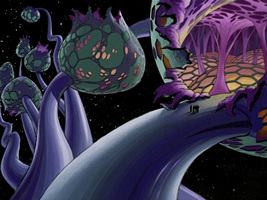
 "Beyond the Farthest Star"
"Beyond the Farthest Star"